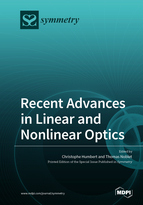Recent Advances in Linear and Nonlinear Optics
A special issue of Symmetry (ISSN 2073-8994). This special issue belongs to the section "Physics".
Deadline for manuscript submissions: closed (30 November 2021) | Viewed by 21360
Special Issue Editors
Interests: linear and nonlinear optics; sum–frequency generation spectroscopy; surface and interfaces; metal and semiconducting nanomaterials and nanoparticles; electrochemistry; sensors; physical chemistry
Interests: physical chemistry; nanophysics; condensed matter physics; nonlinear optics; fluorescence; sum frequency generation spectroscopy; surface chemistry
Special Issue Information
Dear Colleagues,
Sight is the dominant sense of mankind to apprehend the world at the earth-scale and beyond the frontiers of the infinite, from the nanometer to the incommensurable. Primarily based on sunlight and natural and artificial light sources, optics has been the major companion of spectroscopy since scientific observation began. The invention of the laser (optical maser) in the early sixties has boosted optical spectroscopy through the intrinsic or specific symmetry electronic properties of materials at the multiscale (birefringence, nonlinear and photonic crystals), revealed by the ability to monitor light polarization inside or at the surface of designed objects.
This Special Issue of Symmetry features articles and reviews that are of tremendous interest to scientists who study linear and nonlinear optics, all oriented around the common axis of symmetry. We seek contributions that transverse the entire breadth of this field, including those concerning polarization and anisotropy within colloids of chromophores and nanoparticles probed by UV-visible and fluorescence spectroscopies; microscopic structures of liquid–liquid, liquid–gas, and liquid–solid interfaces; surface- and symmetry-specific optical techniques, including ellipsometry, phase modulation infrared reflection absorption spectroscopy, second-harmonic and sum-frequency generations, and surface-enhanced and coherent anti-Stokes Raman spectroscopies; orientation and chirality of bio-molecular interfaces; symmetry-breaking in photochemistry; symmetric multipolar molecules; reversible electronic energy transfer within supramolecular systems; photonic crystals from one to three dimensions, nonlinear crystals; and light polarization in laser sources.
Dr. Christophe Humbert
Dr. Thomas Noblet
Guest Editors
Manuscript Submission Information
Manuscripts should be submitted online at www.mdpi.com by registering and logging in to this website. Once you are registered, click here to go to the submission form. Manuscripts can be submitted until the deadline. All submissions that pass pre-check are peer-reviewed. Accepted papers will be published continuously in the journal (as soon as accepted) and will be listed together on the special issue website. Research articles, review articles as well as short communications are invited. For planned papers, a title and short abstract (about 100 words) can be sent to the Editorial Office for announcement on this website.
Submitted manuscripts should not have been published previously, nor be under consideration for publication elsewhere (except conference proceedings papers). All manuscripts are thoroughly refereed through a single-blind peer-review process. A guide for authors and other relevant information for submission of manuscripts is available on the Instructions for Authors page. Symmetry is an international peer-reviewed open access monthly journal published by MDPI.
Please visit the Instructions for Authors page before submitting a manuscript. The Article Processing Charge (APC) for publication in this open access journal is 2400 CHF (Swiss Francs). Submitted papers should be well formatted and use good English. Authors may use MDPI's English editing service prior to publication or during author revisions.
Keywords
- UV-visible absorption, fluorescence, photoluminescence
- ellipsometry
- PM-IRRAS spectroscopy
- SHG
- SFG 2nd order nonlinear spectroscopy
- Raman/SERS /CARS 3rd nonlinear order spectroscopy
- nonlinear plasmonics
- nanophotonics
- symmetry in photonic crystals (1D, 2D, and 3D)
- symmetry in nonlinear crystals
- symmetry of surfaces and interfaces
- light polarization in laser sources







